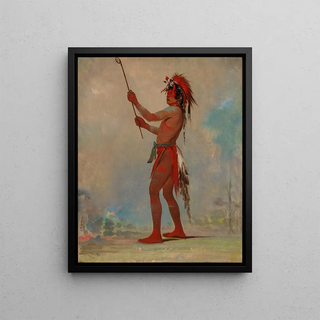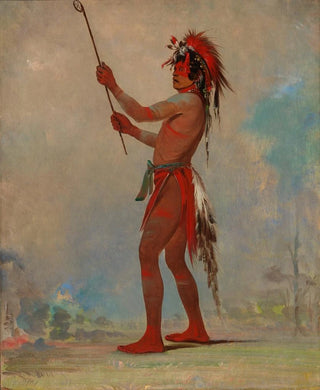Art print | WeChshTaDoTa Red Man, a distinguished ball player - George Catlin Source: Reproduction | WeChshTaDoTa Red Man, un joueur de balle distingué - George Catlin


View from behind

Frame (optional)
In the vast panorama of American art history, the artwork "WeChshTaDoTa Red Man, un joueur de balle distingué" by George Catlin stands out for its narrative depth and commitment to representing Native American cultures. This painting, emblematic of Catlin's interest in the life and traditions of indigenous peoples, invites viewers to immerse themselves in a world rich in symbols and meanings. Through this piece, the artist transports us to a moment of celebration, where the ball player, dressed in traditional ornaments, embodies the spirit and pride of a disappearing culture. The art print of this work thus offers a window into a fascinating past, while emphasizing the importance of preserving these cultural stories.
Style and uniqueness of the work
George Catlin's style is characterized by a meticulous attention to detail and an almost documentary approach, reflecting his desire to capture the authenticity of his subjects. In "WeChshTaDoTa Red Man, un joueur de balle distingué," vibrant colors and delicate textures blend to create a lively atmosphere. The artist employs painting techniques that highlight the richness of the player's costumes and accessories, while incorporating elements of the surrounding landscape that evoke the natural environment of Native American tribes. This painting does not merely depict an individual; it tells a story, that of a people and their traditions, through a gaze that is both respectful and admiring. The posture of the player, his concentration, and the palpable energy emanating from the scene capture the very essence of a moment of play, a competition where honor and community are at stake.
The artist and his influence
George Catlin, born in 1796, is often regarded as one of the first artists to document Native American cultures with such dedication. Traveling across the United States, he encountered numerous tribes and dedicated his life to immortalizing their ways of life, beliefs, and traditions. His work not only contributed to the recognition of Native American art but also raised public awareness about

Matte finish

View from behind

Frame (optional)
In the vast panorama of American art history, the artwork "WeChshTaDoTa Red Man, un joueur de balle distingué" by George Catlin stands out for its narrative depth and commitment to representing Native American cultures. This painting, emblematic of Catlin's interest in the life and traditions of indigenous peoples, invites viewers to immerse themselves in a world rich in symbols and meanings. Through this piece, the artist transports us to a moment of celebration, where the ball player, dressed in traditional ornaments, embodies the spirit and pride of a disappearing culture. The art print of this work thus offers a window into a fascinating past, while emphasizing the importance of preserving these cultural stories.
Style and uniqueness of the work
George Catlin's style is characterized by a meticulous attention to detail and an almost documentary approach, reflecting his desire to capture the authenticity of his subjects. In "WeChshTaDoTa Red Man, un joueur de balle distingué," vibrant colors and delicate textures blend to create a lively atmosphere. The artist employs painting techniques that highlight the richness of the player's costumes and accessories, while incorporating elements of the surrounding landscape that evoke the natural environment of Native American tribes. This painting does not merely depict an individual; it tells a story, that of a people and their traditions, through a gaze that is both respectful and admiring. The posture of the player, his concentration, and the palpable energy emanating from the scene capture the very essence of a moment of play, a competition where honor and community are at stake.
The artist and his influence
George Catlin, born in 1796, is often regarded as one of the first artists to document Native American cultures with such dedication. Traveling across the United States, he encountered numerous tribes and dedicated his life to immortalizing their ways of life, beliefs, and traditions. His work not only contributed to the recognition of Native American art but also raised public awareness about






